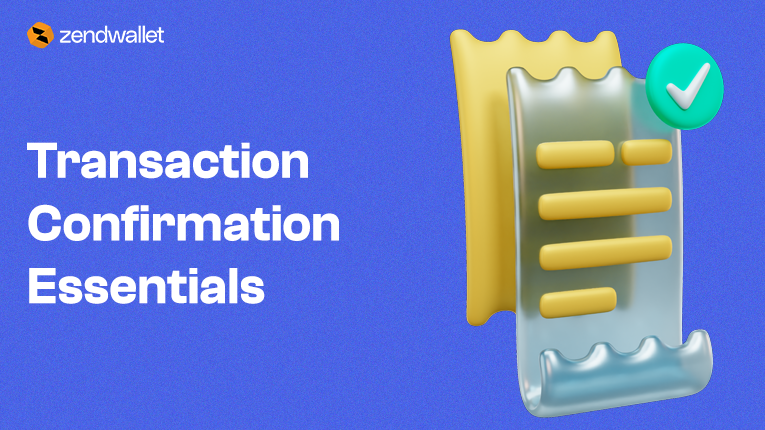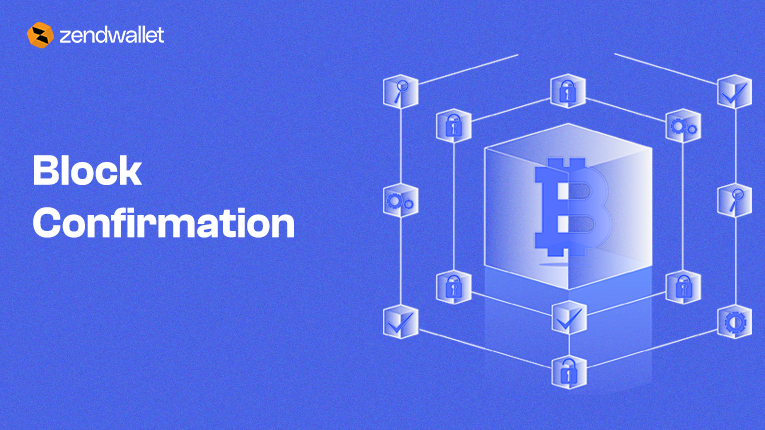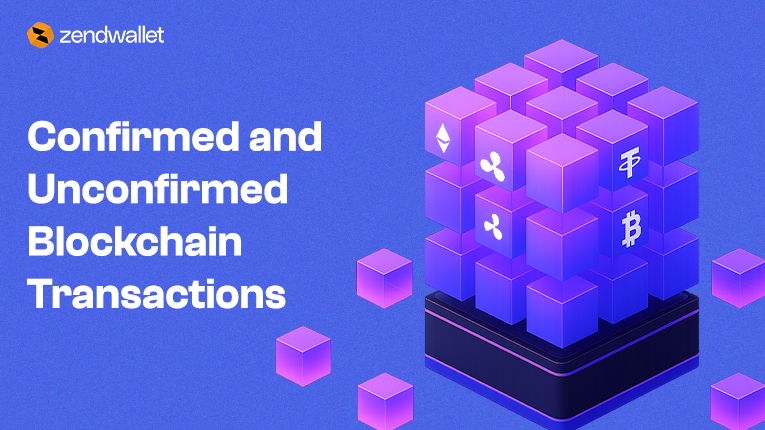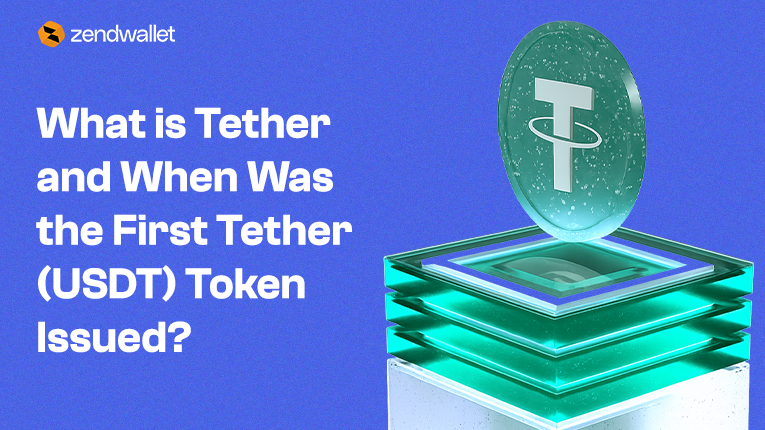Unconfirmed blockchain transactions mark the beginning of every crypto transfer, sitting in the network before joining the blockchain.
A confirmed transaction occurs when miners include it in a block, making it secure, permanent, and visible to everyone on the network.
Understanding this process helps you track payments, plan transfers, and feel confident when sending or receiving crypto.
With ZendWallet, you can follow each transaction in real time, from its initial confirmation to being fully confirmed and ready to use.
Transaction Confirmation Essentials

- Unconfirmed transactions live in the mempool of network nodes until they are included in a block.
- A transaction becomes confirmed once miners add it to a block.
- Most wallets and exchanges require several confirmations before crediting deposits.
- Transactions with no or low fees may get stuck in the mempool.
How Block Confirmations Work

When a crypto transaction is sent from a wallet, it is broadcast to the network. Nodes hold unconfirmed transactions in the mempool, and miners select which transactions to include in the next block.
Once a transaction is added to a block, it receives its first confirmation. At this point, the transaction is much harder to reverse, although it may not yet be fully finalized.
Multiple confirmations are recommended for the following reasons:
- Security: The deeper a block is in the chain, the more difficult it becomes to hack or reverse.
- Chain consistency: Occasionally, two miners may create a block at the same time, forming a temporary parallel chain. The network eventually decides which chain is valid, and blocks on the abandoned chain are discarded.
Accepting transactions with only one confirmation could result in funds appearing and disappearing unexpectedly.
Each blockchain and wallet sets its own rules for the number of confirmations required. For example:
- Ethereum transactions: Average block time is under 20 seconds. Bitstamp by Robinhood requires 12 confirmations for an ETH deposit. With sufficiently high gas fees, a transfer can complete in about 4 minutes.
- Bitcoin transactions: Average block time is about 10 minutes. Because Bitcoin blocks are more secure, fewer confirmations are typically required. Bitstamp by Robinhood requires 3 confirmations for BTC deposits.
What Are Unconfirmed Blockchain Transactions?
Unconfirmed blockchain transactions are transactions that have been broadcast to the network but have not yet been included in a block. They are visible on a blockchain explorer but are still considered pending.
For example, if you send 0.5 BTC from your wallet, you might see a status of zero confirmations on Blockchain.com. This means the network knows about the transaction, but miners have not yet added it to a block. Until it is confirmed, the transaction is technically not finalized.
Even though it is unconfirmed, your transaction is not lost. It’s still in the network’s queue, waiting for confirmation. The blockchain explorer allows you to track these unconfirmed transactions in real time, so you know exactly where your funds are.
Common Reasons for Unconfirmed Blockchain Transactions
There are several reasons why a blockchain transaction might remain unconfirmed:
- Low network fees: Miners prioritize transactions that offer higher fees. If your fee is too low, your transaction may take longer to confirm.
- Network congestion: During busy periods, even transactions with standard fees can stay unconfirmed as the network handles a high volume of pending transactions.
- Double-spend attempts or nonce conflicts: Occasionally, technical conflicts can delay confirmation.
For example, during a surge in Bitcoin activity, a transaction with a low fee can remain unconfirmed for hours, while transactions with higher fees get confirmed faster.
How to Check a Blockchain Explorer Unconfirmed Transaction
Checking an unconfirmed transaction is simple using a blockchain explorer:
- Copy the transaction hash (TXID) from your wallet.
- Open a blockchain explorer like Blockchain.com for Bitcoin or Etherscan for Ethereum.
- Paste the transaction hash into the search bar.
- Look at the confirmations section. If it shows zero confirmations, your transaction is unconfirmed.
With our platform, ZendWallet, you can view the status of every transaction directly within the app. Transactions are tracked in real time, so you always know if your crypto is moving or waiting for confirmation.
How to Fix or Speed Up Unconfirmed Blockchain Transactions
If your transaction is unconfirmed, there are a few ways to address it:
- Increase the transaction fee: Some blockchains allow you to replace the original transaction with a higher fee, which helps miners prioritize it. Ethereum users, for example, can use the “speed up” option in their wallet.
- Cancel and resend: Some wallets allow cancellation of an unconfirmed transaction, letting you resend it with a higher fee.
- Wait for the network: Often, unconfirmed transactions eventually clear once congestion decreases.
Using ZendWallet, gas fees and transaction priorities are automatically adjusted based on live network conditions. This means fewer unconfirmed transactions and faster transfers without you having to manually calculate fees.
Confirmed vs Unconfirmed Transactions
A confirmed transaction has been included in a block and validated by network nodes. Once confirmed, the transaction is final and cannot be reversed.
An unconfirmed transaction, on the other hand, is still pending. While it is visible on blockchain explorers, it has not yet been validated and is not considered final.
For instance, if you send 100 USDT to a friend, an unconfirmed transaction will appear as pending on Etherscan.
Once it gets its first confirmation, the transaction is secure, and the recipient can safely consider the funds available.
The Impact of Unconfirmed Blockchain Transactions
Unconfirmed blockchain transactions can have real-world effects:
- Payments can be delayed, which may disrupt trading or purchases.
- Users may feel uncertain about whether funds were sent successfully.
- Businesses may experience delays in receiving payments, affecting cash flow.
Our platform, ZendWallet helps minimize these issues by providing real-time transaction tracking and dynamic fee adjustment, so unconfirmed transactions are rare. Users know exactly when funds are received or confirmed.
How Blockchain Technology Works: A Step-by-Step Guide
Best Practices to Avoid Unconfirmed Blockchain Transactions
To reduce the chance of unconfirmed transactions:
- Always set a sufficient fee relative to network traffic.
- Check current network congestion before sending crypto.
- Use trusted wallets like ZendWallet with built-in fee estimators.
- Verify the transaction on a blockchain explorer if it remains unconfirmed for longer than expected.
By following these steps, you can make sure your crypto transactions go through quickly and safely.
Why Tether and ZendWallet Make It Easier
For users sending Tether (USDT), unconfirmed transactions can be tracked and managed quickly.
ZendWallet allows you to hold, trade, and send USDT for payments or transfers across Africa and beyond.
Every transaction can be tracked in real time, reducing uncertainty and making digital payments more reliable.
You can aslo read: The Best USDT Trading Platform in Nigeria | Best Site to Buy USDT in Nigeria
Conclusion
Unconfirmed blockchain transactions are a normal part of sending cryptocurrency. They are temporary and usually get confirmed once miners validate them or fees are adjusted.
Using wallets like ZendWallet makes it easy to manage and track every transaction. Always check your transaction on a blockchain explorer if it appears unconfirmed, it’s just waiting to be included in a block. With the right wallet, blockchain transactions become faster, safer, and more transparent.
You can also watch this : https://youtu.be/8c7BoO0WRe8?si=GSDkDZtUz6ykobUO



